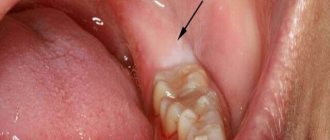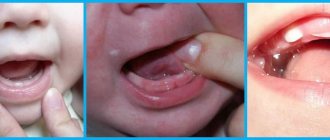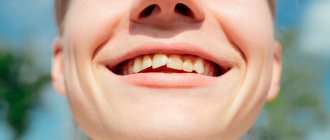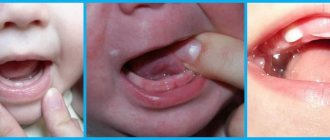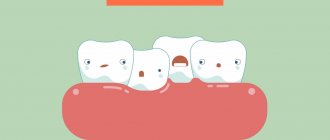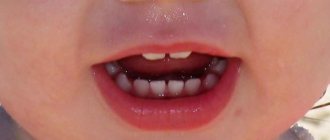- Crooked teeth
- The appearance of a second row of teeth in the jaw
- When permanent teeth do not appear for a long time
- How to distinguish baby teeth from permanent ones?
The complex process of replacing baby teeth with permanent ones is often painful and accompanied by a number of problems. The most common of them is malocclusion. The second most common problem is the appearance of a second set of teeth. Also, many parents are faced with the fact that their child’s molars and incisors do not appear for a very long time.
How to Reduce Teething Pain
Fever and pain can be reduced by:
- massage the gums where tooth eruption is expected;
- the gums can be lubricated with an anesthetic;
- give the child a vasoconstrictor if the child has a runny nose;
- if the temperature rises above +38C, then the child should be given an antipyretic in the form of a sweet syrup.
Usually, the eruption of baby teeth occurs without complications. In some cases, a complication may occur that is caused by:
- Presence of a dental cyst.
- When the baby tooth has not yet come out, but it is supported by a permanent tooth.
- When a fang erupts, it is out of place in the dentition.
What teeth are called eye teeth?
Eyeteeth is a folk term, not a medical one. In common parlance, this is usually what the upper canines are called, and by analogy with them, the lower ones too.
Probably, the fangs received their special name due to the fact that next to them there are branches of the facial nerve, when irritated, severe pain occurs, spreading to the upper half of the face and radiating into the eyes. That is why, when a child develops baby eye teeth, it is accompanied by excruciating pain and other unpleasant symptoms. And because of this, removing fangs in adults is a very painful procedure that requires serious anesthesia.
Despite their name, eye teeth do not affect vision in any way. Although quite often dental patients express the opinion that if a fang is removed they can easily go blind, such a prejudice has no medical evidence and is erroneous.
Eye teeth in older children
Permanent eye teeth erupt in children aged 9-12 years. Normal eye tooth eruption should occur painlessly. If pain still bothers the child, it may be caused by:
- the presence of infection in the oral cavity;
- periodontal disease;
- development of dental caries.
The eye teeth may erupt in a crooked manner. Orthodontic treatment helps correct abnormal tooth growth. If a tooth erupts and grows incorrectly, it is removed on the advice of a dentist. After removing an eye tooth, it must be immediately replaced with a prosthetic so as not to disrupt the integrity of the dentition and not to impair the process of chewing food.
Features in adults
Although eye teeth tend to be more of a concern for young children, adults also often have questions related to some type of canine problem.
- At what age does the replacement of primary canines with permanent ones occur? Typically, the eye teeth on the upper jaw appear a little later than on the lower jaw. The approximate age when the lower canines grow is 9-10 years, and the upper ones are 11-12 years.
- How many permanent eye teeth appear and can they erupt before the front teeth? The canines appear fifth in the permanent dentition - after the first molars (5-6 years), central and lateral incisors (6-9 years), and first premolars (10-12 years). Violation of this pattern of eruption of permanent teeth can be both an individual characteristic of a person and a sign of serious dental pathology (for example, adentia due to the death of the rudiments of permanent teeth).
- Why can an eye tooth hurt? Normally, a healthy person should not have any pain in the teeth. If the eye tooth still hurts, then this may be a sign of a serious pathology: periostitis (flux), pulpitis, periodontitis and others. In any case, you should not engage in independent treatment - it is better to consult a dentist for qualified help. The only thing you can do before visiting the doctor is take a pain reliever.
- What to do if the eye tooth has grown incorrectly? Dental anomalies in the form of crooked teeth are quite common. In some, this defect is practically invisible, but sometimes the fangs erupt at a considerable distance from their intended place. This situation can be corrected by orthodontic treatment (braces, mouth guards), but sometimes, in especially severe cases, the doctor suggests pulling out a crooked tooth to straighten the dentition.
- Is it possible to remove eye teeth? Removing any tooth is an extreme measure that the dentist will only take as a last resort. And fangs are no exception to the rule. Premature loss of a baby eye tooth can lead to the formation of malocclusion, and its removal in an adult significantly impairs the chewing function of the teeth and also negatively affects a person’s appearance. But if you still had to pull out a fang, then you should have it prosthetically installed as early as possible.
While the eye teeth are special, the importance of the rest cannot be underestimated. It is necessary to carefully monitor the condition of the oral cavity - only this will help maintain a healthy and beautiful smile until old age.
How to reduce pain in an eye tooth using traditional medicine
Dental treatment of the eye tooth can be supplemented with treatment with traditional medicine. Typically, after visiting a dentist in a specialized clinic, they advise the following:
- Dissolve a teaspoon of baking soda or salt in a glass of warm water. Rinse your mouth with this solution several times a day.
- Prepare a decoction of medicinal herbs: chamomile, sage, or make an infusion of oak bark. Rinse your mouth with prepared decoctions and infusions several times a day.
The eruption of eye teeth in children should occur under the supervision of a pediatric dentist. Adults who have problems with their eye teeth should also see a dentist.
Crooked teeth
If permanent teeth begin to grow unevenly, you need to come for a consultation with an orthodontist at the A-Medic Network of Medical Clinics as soon as possible. The sooner such a decision is made, the easier it will be for the dentist to correct their growth. An incorrect bite is not only inconvenient, it can lead to the development of a number of diseases, for example, caries, stomach diseases, and cause childhood and teenage complexes and psychological problems.
The easiest way to straighten your jaw is to wear braces. It is very important for parents, together with the attending physician, to explain to the child that temporary inconveniences when using braces are justified and will bring invaluable benefits in the future. You need to take good care of it, because it will stay in your mouth for at least six months. This design will work most effectively during adolescence. Small children can more easily tolerate plates or trainers, which look something like boxing mouthguards, rather than braces. Children's enamel is quite delicate, so trainers that do not damage it will be the best way to correct a child's malocclusion.
Teething disorders - symptoms and treatment
In case of teething problems, symptomatic treatment is carried out. Its purpose is to eliminate pericoronitis, oral abscess and osteomyelitis.
Treatment of pericoronitis
Treatment of pericoronitis is carried out on an outpatient basis. If the tooth germ is positioned correctly and there is enough space for the dental arch, then surgical treatment is the most preferable option. The mucous membrane in the area of the tooth crown is completely excised. As a result, access to the chewing and lateral surfaces of the crown appears. The operation is performed under anesthesia and can be performed either with scissors or a scalpel, or with more modern methods: cryodestruction, laser and electric knife.
pericoronarotomy can be performed - an operation during which the mucous membrane above the tooth crown is dissected. As a result, tooth surfaces that were previously covered by a hood of mucous membrane are exposed.
After surgical treatment, drug therapy :
- Antibacterial agents are selected individually, taking into account the microflora. It can be:
- Inhibitor-protected penicillins that destroy anaerobic and aerobic microorganisms. Amoxicillin with clavulanic acid is most effective.
- Lincomycin and Clindamycin act against Staphylococcus aureus.
- Metronidazole is not effective against facultative anaerobes and aerobes, but together with other antibiotics it will help cope with mixed microflora.
- Cephalosporins act only together with Metronidazole and Clindamycin, since almost all anaerobic microorganisms are insensitive to them.
- The latest generations of fluoroquinolones are effective against gram-positive bacteria, but each drug has its own level of activity.
- Non-steroidal anti-inflammatory drugs.
- Antihistamines [10].
- Detoxification therapy consists of drinking plenty of warm drinks rich in vitamins, such as compotes and fruit drinks. Sometimes in difficult situations, an isotonic solution is administered intravenously.
To alleviate local symptoms and reduce inflammation, baths with antiseptic solutions are used: a pale pink solution of potassium permanganate, 0.01% Miramistin solution or 0.05% Chlorhexidine.
Treatment of oral abscess
Treatment for an oral abscess includes surgery and medication. Depending on the location of the abscess and the general condition of the patient, it can be performed in a clinic or in a hospital. During the operation, the purulent-inflammatory focus is opened, the postoperative wound is treated with antiseptics and drained.
After surgery, medications must be prescribed. They are similar to those used to treat pericoronitis. To detoxify, it is recommended to drink plenty of alkaline liquids, such as mineral water and cranberry juice.
For several days after the operation, the wound is bandaged daily and treated with antiseptics.
Treatment of osteomyelitis
If osteomyelitis is detected, the patient is immediately hospitalized. The erupting tooth is removed, and all purulent foci are carefully treated. Antibacterial drugs are administered intravenously. For detoxification, saline solutions are used, which are also administered intravenously.
When permanent teeth do not appear for a long time
The absence of permanent teeth for too long can be due to several reasons: these are the genetic characteristics of the body, their immaturity, and the destruction of tooth germs by some kind of infection.
Only a dentist can determine the true cause. At the A-Medic Network of Medical Clinics clinic, they will take a picture of the jaw, which will show how the child’s permanent teeth are formed. Sometimes they can grow inside the gums. If nothing is visible on the image, the doctor may suggest solving the problem by installing dentures.
Features of canine correction with braces
The problem can be solved with or without tooth extraction. Both methods help to obtain the space that is missing, but necessary for the dystopic canine to be returned to its place. The choice of the optimal option depends on the clinical situation.
- If removal is not performed, free space is formed due to the gradual lengthening of the dentition with braces. The doctor must assess in advance how the process will affect the proportions of the face.
- If changes in appearance turn out to be negative (for example, the front teeth deviate noticeably forward), a pair of teeth will have to be removed - usually the first premolars.
There is no need to be afraid of removing completely healthy teeth. This method will be suggested by the doctor only if absolutely necessary - to improve chewing function, balance load distribution and maintain the health of the remaining teeth. Due to the free distribution of tooth roots, in this case a stable correction result that is not prone to relapse will be achieved.
Orthodontic patients often ask: is it possible to put braces on one jaw? Dystopic fangs are just that case. If there is a need for significant straightening of the canines with braces on the upper jaw and minor correction of the lower dentition, the lower bracket can be installed later, which is more financially beneficial for most patients.
Temperature during teething: causes, duration
When teething, the child's body experiences severe stress and reacts to this with an increased temperature. In order not to confuse a common cold and teething fever, you need to know what exactly happens when teeth are cut.
The reason for the increase in temperature during teething Temperature does not just happen. The child’s body reacts in this way to the inflammation of the gums, through which the tooth will soon emerge. At this time, immunity at the site of the future tooth decreases, and various microorganisms begin to become active, which also cause fever. Up to a year, teething occurs more or less calmly and does not cause severe inconvenience, but after a year, when fangs begin to erupt, which take longer to appear, the baby may experience pain, accompanied by fever, for up to several weeks. Often the temperature rises not because of inflammation of the gums, but because of viruses that have entered the body or infection due to reduced immunity. The body uses it to fight them, because they are not able to exist at high temperatures, so they die.
How much can the temperature rise? How much the temperature rises is individual for each organism. Normally, it can vary from 37.5 to 38.5 degrees. It is necessary to measure the temperature every half hour or hour, because in young children it can rise very quickly because their body is not yet able to properly exchange heat. If the temperature begins to reach 39 degrees, you must immediately call an ambulance, because this may mean the appearance of various complications.
Duration Regardless of the examples given, all organisms react differently, so for different children everything can develop according to its own scenario. Usually the temperature lasts 2-3 days and disappears when the tooth erupts. There are also cases when the temperature lasts for 5 or even 7 days, and the temperature can rise and disappear completely after a few hours. Be that as it may, a doctor still needs to be called to examine the baby. To exclude complications and a number of other diseases, so that if something happens, they can be treated as early as possible.
What are the symptoms besides fever? Temperature is not the only sign of teething. At the same time, a runny nose may occur due to the spread of swelling from the gums to the nasal mucosa. This happens when the upper teeth erupt. Also one of the symptoms is excessive salivation and weak stool of the baby.
What symptoms should you be wary of? Due to reduced immunity, the child’s body is not able to fight many viruses and infections. The following signs may indicate their presence: • the nose is very stuffy, and snot flows from it in large quantities. This means that rhinitis has joined the edema, it must be treated; • diarrhea. Very rarely it appears along with a temperature, but it still happens. This could mean some kind of intestinal infection acquired by the baby through toys; • cough. Due to severe drooling, children do not always have time to swallow saliva, so they can sometimes choke on it, resulting in coughing. If the cough is repeated systematically and there are signs of sputum, then inflammation of the respiratory tract has been added to the temperature; • reddened throat. In addition to the nasal mucosa, swelling can also spread to the mucous membranes of the throat. This may mean the appearance of pharyngitis or acute respiratory infections; • nausea and vomiting. They occur at a very high temperature, perhaps this is a symptom of an intestinal infection or damage to the nervous system. If your baby exhibits these signs, you should immediately consult a doctor who will prescribe the necessary treatment, regardless of the presence of fever.
What measures to take in case of high temperature? Many parents begin to give antipyretic and antiviral drugs when the temperature rises slightly. This cannot be done, because you need to allow the body to fight the virus on its own. Abuse of such drugs can lead to addiction, and the body will not be able to cope with infections and viruses on its own in the future. Pediatricians advise not to lower the temperature until it reaches 38 degrees, because you need to let the body fight. If the effectiveness of antipyretic drugs is low, you can wipe the baby with slightly cool water or rub it with an alcohol solution with the addition of vinegar. Sometimes parents resort to a method such as homeopathy, but with the help of these remedies they will not be able to effectively reduce the temperature, although they can generally improve the condition of the baby. If the temperature does not subside for more than 3 days, you should consult a doctor.
Is it possible to walk when there is a fever? If the baby’s health is normal and the temperature is not too high, then a walk in the fresh air will only bring benefits. Only the child needs to be dressed according to the weather. You need to walk calmly so that he doesn’t get overtired. Even if you are sure that the temperature is a consequence of teething, you still need to call a doctor who will make an accurate diagnosis and prescribe the correct treatment. Self-medication in this case is unacceptable, because if you make a mistake, you can harm the baby’s health.
Sign up for treatment and consultation with a pediatric dentist!
